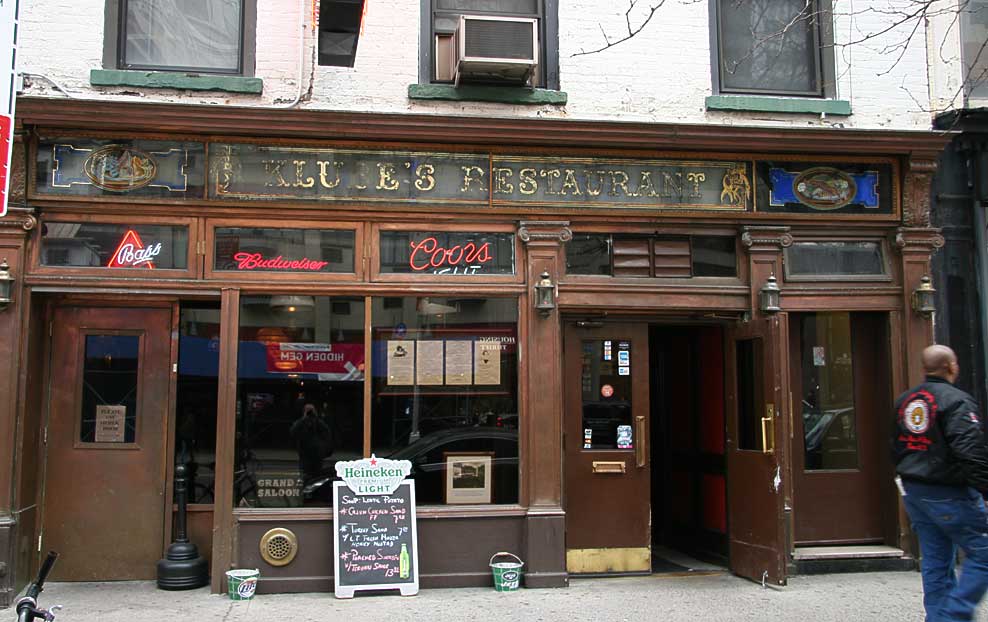
Klube's Restaurant, 158 E. 23rd St. (2007)

A sign in the window of the Grand Saloon, 158 E. 23rd St. proclaims "Fine Food and Drink Since 1880." The history goes on as follows: "The Grand Saloon's building was constructed in 1843. In 1880 it became the 'St. Blaize Hotel & Restaurant' - which was one of the finest brothels in the city at the turn of the century ... In 1911, the property changed hands and became 'Klube's Steak House'. Klube's established itself as an old-time family run business, catering to the locals with fine food and spirits. It was at this time that Mr. Klube, installed our unique copper fašade. In the midst of prohibition, a secluded back room of Klube's housed one of the city's most popular speakeasy's."
Presumably the glass sign reading Klube's Restaurant was installed at the time of the copper facade - i.e., 1911. The two end pieces (showing plates of food) seem to be newer.
The St. Blaise Hotel receives only passing mention in City of Eros: New York City, Prostitution, and the Commercialization of Sex, 1790-1920 by Timothy J. Gilfoyle (1992), p. 246. Modest "hotels like the Delevan, the German Hotel, and the St. Blaise were subdivided row houses that resembled parlor houses from the outside. They had between 15 and 50 rooms that were used by prostitutes who frequented the hotels or nearby saloons."
The St. Blaise Hotel is listed in city directories from 1901 to 1917. But the name pre-dates these listings. A story in the New York Times (22 July 1898, p. 12), for instance, identifies Frederick Langhurst [sic] as "proprietor of the St. Blaise Hotel, in East Twenty-third Street." The Langhorst brothers, August and Frederick, appear in the city directories from 1882 through 1898 as beer and liquor dealers (which may mean they owned saloons). Trow's New York City Directory for 1888 has Frederick W. Langhorst at 158 E. 23rd St. So he was operating either a saloon or hotel (likely both) here by that time. When the hotel became known as St. Blaise is not clear, maybe at a later date.
The U. S. Census of 1900 shows 10 lodgers living at 158 E. 23rd St., including Fred Langhorst. But this Fred Langhorst was only 20 years old. So he cannot be the Frederick Langhorst who was running a saloon in 1882. That Frederick Langhorst lived at 337 Bleecker St. in 1880. He was 24 year old, and his occupation was recorded as "Lager Beer Saloon." In 1900 he lived at 139 E. 16th St., age 43, born New York Oct. 1856, and his occupation was "Liquor Dealer."
The first indication of Klube's move to 158 E. 23rd St. is the Manhattan telephone directory entry "Klube & Klinger, Hotel" in 1912. Klube was Carl Augustus Klube, born Germany (Saxony) 15 Nov. 1881, died New York?, after 1942, before 1965. Klube's first name is sometimes given in its Americanized form Charles, and sometimes in its German form Karl, but usually he is referred to as Carl A. Klube. He immigrated to the U. S. in 1905, became a naturalized citizen in 1911, registered for the World War I draft in 1918 and for the World War II draft in 1942. In both draft registrations he was the proprietor of Klube's Restaurant, 158 E. 23rd St.
The Klinger in Klube & Klinger was Henry Klinger (1876-1956). He was Carl A. Klube's brother-in-law. Klinger was a butcher, and after his partnership with Klube at the St. Blaise Hotel, he returned to his trade and ran a butcher shop at 102 2nd Ave. (near 6th St.) from 1917 until his death in 1956. (Klinger's butcher shop continued at this location under the name Klinger & Koester until 1971.)
In the late 1940s or early 1950s Carl A. Klube's place at Klube's Restaurant was taken by his son, Carl Henry Klube (1909-1992). But the restaurant closed when Carl A. Klube's wife, Agnes Klube (1887-1965), died. Klube's was replaced in 1965 by Walsh's Steak House (New York Times, 16 Feb. 1965, p. 57).
< previous || next > index map signs by date signs by name see what's new